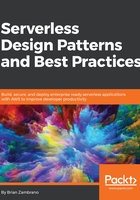
Conventions used
There are a number of text conventions used throughout this book.
CodeInText: Indicates code words in text, database table names, folder names, filenames, file extensions, pathnames, dummy URLs, user input, and Twitter handles. Here is an example: "To test this, we need to set the timeout of the divide function to 4 seconds and put a time.sleep(3) in the middle of the application code."
A block of code is set as follows:
def divide(event, context):
params = event.get('queryStringParameters') or {}
numerator = int(params.get('numerator', 10))
denominator = int(params.get('denominator', 2))
body = {
"message": "Results of %s / %s = %s" % (
numerator,
denominator,
numerator // denominator,
)
}
response = {
"statusCode": 200,
"body": json.dumps(body)
}
return response
When we wish to draw your attention to a particular part of a code block, the relevant lines or items are set in bold:
from raven_python_lambda import RavenLambdaWrapper
@RavenLambdaWrapper()
from raven_python_lambda import RavenLambdaWrapper
@RavenLambdaWrapper()
def divide(event, context):
# Code
Any command-line input or output is written as follows:
$ curl "https://5gj9zthyv1.execute-api.us-west-2.amazonaws.com/dev?numerator=12&denominator=3"
{"message": "Results of 12 / 3 = 4"}
Bold: Indicates a new term, an important word, or words that you see onscreen. For example, words in menus or dialog boxes appear in the text like this. Here is an example: "The following screenshot shows Invocation errors from the AWS Lambda monitoring page for the divide function:"